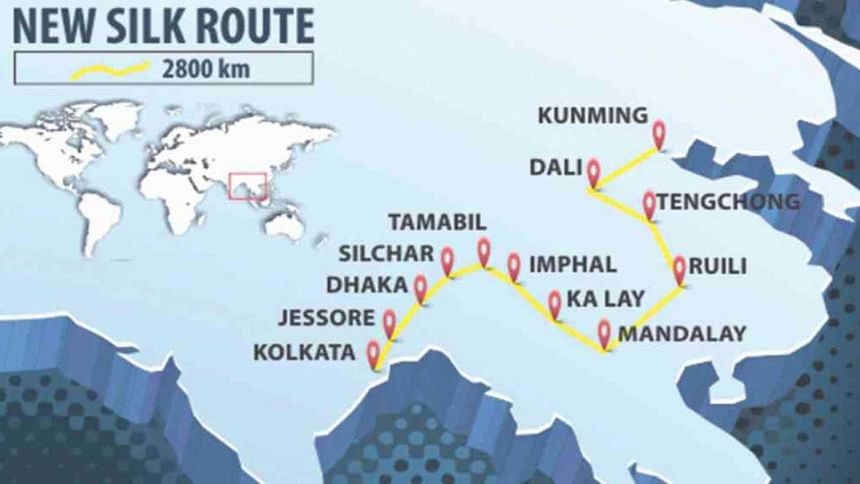BCIM – Economic opportunities for Bangladesh

The Asian Century has begun with the conjunction of the two growth poles of Asia – the East and South Asia through the Bangladesh-China-India-Myanmar Economic Corridor Initiative (BCIM-EC). China and India are the world's second and third largest economies in Purchasing Power Parity terms. Bangladesh and Myanmar, endowed with rich natural and human resources, stand to benefit from harnessing the untapped potential of enhanced connectivity with their two giant neighbours. The economic corridor could enable the four countries to realise accelerated economic growth.
The BCIM concept was coined by scholars in 1998 when they embarked on exploring the opportunities that can be tapped by a regional economic corridor encompassing the four neighbouring countries. Following more than a decade of consultation and deliberation at the track 2 channel, BCIM graduated to an official regional co-operation initiative with high-level endorsement from the respective governments. As a result of the Chinese Premiere's visit to India in 2013, China and India are now in sync regarding the “BCIM-EC” and Bangladesh and Myanmar signalled their interest to take part in the initiative.
The key concept behind the BCIM initiative was that by harnessing the comparative advantage in the respective member countries, each nation could significantly benefit through the operationalisation of crucial infrastructure connectivity and BCIM-wide economic co-operation. Bangladesh would enjoy greater market access to the two most powerful Asian economies namely India and China through elimination of non-tariff barriers and investment in infrastructural development.
Intra-BCIM trade has seen rapid increase from USD 6.0 billion in 2001 to USD 90 billion in 2011. The increase has been chiefly driven by China and India while the contribution of Bangladesh and Myanmar remains negligible. The trade potential is estimated to be around USD 132 billion.Two-way trade between India and Bangladesh was around USD 6.6 billion in 2013-14. The Confederation of Indian Industry thinks that Bangladesh-India trade could double to USD 10 billion in a span of four years, provided trade deterrents like non-tariff barriers and infrastructure-related issues are resolved.
Preferential access to larger Indian and Chinese markets could make Bangladesh a more attractive destination for foreign direct investment. Given the rising outward FDI flows from India and China, these two economic giants can also be a major source of FDI for Bangladesh. Current FDI inflow from both countries to Bangladesh is dismally low. India is the 9th highest investor in Bangladesh while China ranks 13th. India can invest in potential sectors such as the electrical machinery and equipment, vegetable, agro processing, automobiles, textiles, etc. in the manufacturing front and software, pharmaceuticals, hospital and medical equipment, tourism among others in services. China also has highlighted five core areas where it wants to invest - energy exploration, power generation, agriculture, industry, and transportation.
By developing connectivity with China, India, and Myanmar by roads, rail and other ways, Bangladesh can transform itself into a part of an industrial nexus and commercial hub linking up South and Southeast Asia. This could be done through construction of the multimodal Southern Silk Road in the form of shorter and cheaper routes linking India and China through Bangladesh. The China Communications Construction Company Ltd (CCCC) has proposed to build the Bangladesh portion of the silk route that would pass through Dhaka and Chittagong. Indo-Bangladesh connectivity could be strengthened through rail link between Akhaura and Agartala providing a direct railway route between Bangladesh and the North-Eastern States of India thus generating almost 50 percent savings in travel. Road connectivity between Kolkata and the North-East Indian states would cut the distance byhalf. This would be a win-win situation for both the countries since India wouldgain from savings in transport cost and travel time and Bangladesh could tap a new source of earning foreign exchange in the form of transit fee for cargoes and containers. Maritime transport is hamstrung by inadequate port facilities in Bangladesh.
The BCIM-EC initiative is unfolding at a time when China is making transition from an inward-looking nation to a more strategically active member of the international community playing a fundamental role in shaping the pattern of development in the Asia-Pacific. In recent years, China has expressed serious interest to provide financial and technical assistance to Bangladesh over several major initiatives including the deep sea port, the rail bridge over Jamuna River, Dhaka-Comillatrain lines, multi-lane tunnel under Karnaphuli River, etc. The Government of Bangladesh has adopted the plan to establish an economic zone for Chinese investors.
Myanmar's liberalisation might set the ground for better connectivity with Bangladesh. Economic co-operation with Myanmar would spell benefits for Bangladesh in many ways. Myanmar is setting up special economic zones offering investment incentives which may allow Bangladeshi firms to exploit the improving investment climate of its neighbour. The recent discovery of gas reserves in Rakhine State has opened up new corridors of industrial development possibilities. Stronger trade, investment, and people-to-people linkages between the two countries could also set the ground for peaceful and sustainable resolution of issues like the Rohingya question.
The BCIM initiative would also open up new avenues of cross border energy trading for Bangladesh. Bangladesh's installed power generation capacity was 10,289 MW in January 2014. Only 62 percent of the population enjoysaccess to electricity with a per capita availability of 321 kWh per annum. Due to the deficit, Bangladesh has already begun importing power from India and BCIM power co-operation can take this to a new level. Bangladesh should immediately consider power trading with Myanmar since the latter has been going forward to develop hydropower in the Rakhine State with the intent to export and Bangladesh could consider importing from the contiguous state.
A key sector with immense potential is tourism given the historical linkages and colourful cultural diversity across the BCIM region. The four countries have four different religious and cultural make-ups; yet shared legacies could bring them closer. If the road and rail routes are set up, tourists from neighbouring countries could travel to Bangladesh easily and at a low cost. Chinese outbound tourists spent a staggering amount of USD 128.7 billion in 2013 earning China the status of the world's largest outbound tourism market. Indians spent billions on Asia-Pacific tourist destinations and this figure is expected to rise to USD 91 billion by 2030, making Indians the second-biggest overseas travel spenders after China. Bangladesh has to brace itself for getting a chunk of the tourism markets of India, China, and Myanmar which would generate revenue, jobs, and socio-economic development while promoting a better country image abroad.
If the demographic scenario is brought to the limelight, Bangladesh, China, India and Myanmar have a significant population under 25 years of age i.e. 51.1 percent for Bangladesh, 31.8 percent for China, 46.6 percent for India and 44.7 percent for Myanmar. The 1.1 billion young people in the four countries can be brought closer with stronger connectivity. Empowered by economic growth and human development, the youth could be transformed into the innovators, entrepreneurs, and leaders of the future pulling the Asia-Pacific economic juggernaut ahead and building the fabric of peace and harmony.
The BCIM-EC is going to be realised through an incremental process and its impact would take time to bear fruition. However, the politicians, businesses, and other stakeholders need to have a clear picture regarding the challenges and benefits of better economic co-operation in the region. In the long term scenario, each country should aim for comprehensive and sustainable development aimed attranslating the gift of geographical proximity and economic complimentary into dynamic economic ties, practical cooperation, social harmony and good governance. Connectivity would spur faster economic growth in the regionand would cascade into stronger co-operation between South and Southeast Asia. Bangladesh stands to avail manifold opportunities through leveraging the connectivity options for realising concrete and substantial gains in many sectors. The BCIM-EC building will truly be successful if there is collaboration on strategies, policies, plans and measures for co-operation thus bringing about common development and mutual benefits for all the countries.
..............................................................
The writer is a Professor at the Institute of Business Administration (IBA), University of Dhaka.

 For all latest news, follow The Daily Star's Google News channel.
For all latest news, follow The Daily Star's Google News channel. 



Comments